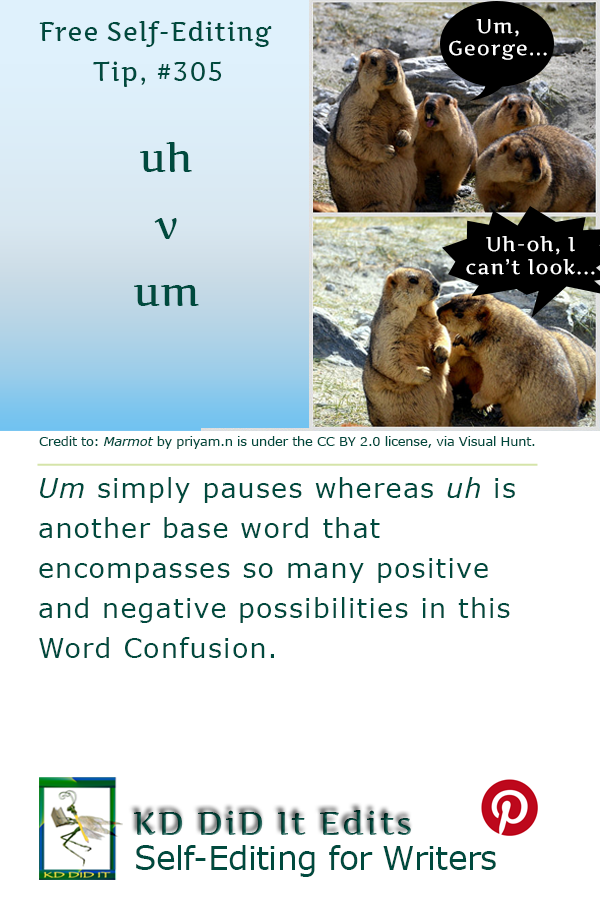Revised as of
7 Jan 2023
I actually got curious about this one when editing a client’s dialogue. He was using a lot of uhs and ums and I started getting confused. I hate that!
As I’ve mentioned before, I make use of these Author Tools as well. The entries are a combination of words that confuse me as well as those that I have found confuse others, and I don’t see much point in hoarding my research to myself, LOL!
You may also want to explore “Huh? What’s That You Say?” and “‘Em, ‘Er, ‘Im . . .“.
Word Confusions . . .
. . . started as my way of dealing with a professional frustration with properly spelled words that were out of context in manuscripts I was editing as well as books I was reviewing. It evolved into a sharing of information with y’all. I’m hoping you’ll share with us words that have been a bête noire for you from either end.
If you found this post on “Uh versus Um” interesting, consider subscribing to KD Did It, if you’d like to track this post for future updates.
You may also want to take a peek at “Hmmm versus Mmmm” or “Huh, What’s That You Say?“
| Uh | Um | ||||||||||||||||||||
|---|---|---|---|---|---|---|---|---|---|---|---|---|---|---|---|---|---|---|---|---|---|
| Other Countries Use . . . | |||||||||||||||||||||
|
|
||||||||||||||||||||
| The Clark-Tree study mentioned that regional differences exist in the spelling and/or use of fillers that may replace the uh and um. If any of y’all know of some, I’d love to add it to the list! | |||||||||||||||||||||
| Rule: Both are used to indicate the speaker is “searching for a word, deciding what to say next, want to keep the floor, or want to cede the floor” (Clark, 76). Both words are considered performance additions, fillers.
A character using either word may be characterized as a slow speaker; using um more often than uh can be used to indicate a really slow speaker (Clark, 98). However, a “successful” character is unlikely to use either word. Using these fillers could be useful to indicate that the “successful” character is in an uncomfortable and unfamiliar situation . . . snicker. Always separate from the rest of the sentence with commas when used as interruptions. DO use hyphens between “uh-oh”s and “uh-huh”s. |
|||||||||||||||||||||

|

Pause by SphotoE is under the CC BY 2.0 license, via VisualHunt. — “Um, I’m, um, not sure if we should, um, do this . . .” |
||||||||||||||||||||
| Part of Grammar: | |||||||||||||||||||||
| Adjective Exclamation Preposition |
Exclamation | ||||||||||||||||||||
| General Rule: | |||||||||||||||||||||
| Initiates a brief delay in speech (Clark, 73 & 79) | Initiates a longer delay in speech | ||||||||||||||||||||
| Adjective: Nonstandard spelling of the indefinite article a Used to represent black English Exclamation: Expresses surprise, bewilderment, disbelief, contempt, or interrogation Alternative for huh [uh-oh] Indicating a mistake or surprise Preposition: Used to represent black English |
Natural utterance
Expressing hesitation or a pause in speech |
||||||||||||||||||||
| Examples: | |||||||||||||||||||||
| Adjective: Got me some crabs in uh basket. Exclamation: I was just, uh, passing by. Uh-oh, I spilled my juice. Uh-oh, I think I hear someone coming! Preposition: |
Anyway, um, I was just thinking that, um, we could . . .
So, anyway, I was, like, um, heading over to, um, Julie’s, if you, um, want to come along. Tom came over for, um, a booty call, y’know. I, um, was wondering if you, um, could, help me with this, um, thing. |
||||||||||||||||||||
|
|||||||||||||||||||||
| History of the Word: | |||||||||||||||||||||
| Its use was first noticed between 1595 and 1605.
The combination was first used in the 1920s. |
It was first recorded in English in the early 17th century.
The combination was first used in the 1920s. |
||||||||||||||||||||
C’mon, get it out of your system, bitch, whine, moan . . . which words are your pet peeves? Also, please note that I try to be as accurate as I can, but mistakes happen or I miss something. Email me if you find errors, so I can fix them . . . and we’ll all benefit!
Satisfy your curiosity about other Word Confusions on its homepage or more generally explore the index of self-editing posts. You may also want to explore Book Layout & Formatting Ideas, Formatting Tips, Grammar Explanations, Linguistics, Publishing Tips, the Properly Punctuated, Writing Ideas and Resources, and Working Your Website.
Resources for Uh versus Um
Apple Dictionary.com
Clark, Herbert H. and Jean E. Fox Tree. “Using Uh and Um in Spontaneous Speaking.” Social Sciences. Department of Psychology. University of California-Santa Cruz. 27 Feb 2002. Web. n.d. <http://www.columbia.edu/~rmk7/HC/HC_Readings/Clark_Fox.pdf>.
Dictionary.com: uh
“Insurance – Quick Start: Um vs Uh.” Speechink. n.d. Web. n.d. <http://www.speechink.com/transcribers/insurance_quickstart#Um_Uh>.
Pinterest Photo Credits
Marmot, <https://visualhunt.com/f2/photo/15340410975/9452988e70/>, by priyam.n, <https://visualhunt.com/author/8c7d43>, is under the CC BY 2.0 license, via VisualHunt.


